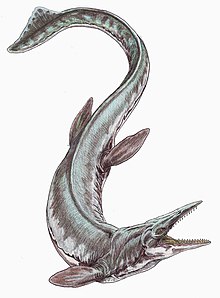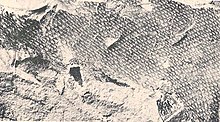海王龍屬
| 海王龍屬 化石時期:
| |
|---|---|

| |
| 科學分類 | |
| 界: | 動物界 Animalia |
| 門: | 脊索動物門 Chordata |
| 綱: | 爬蟲綱 Reptilia |
| 目: | 有鱗目 Squamata |
| 總科: | †滄龍總科 Mosasauroidea |
| 科: | †滄龍科 Mosasauridae |
| 亞科: | †海王龍亞科 Tylosaurinae |
| 屬: | †海王龍屬 Tylosaurus Marsh, 1872 [1] |
| 模式種 | |
| 船首海王龍 Tylosaurus proriger Cope, 1869
| |
| 種 | |
| |
| 異名 | |
| |
海王龍屬(屬名:Tylosaurus)又名瘤龍、節龍,意為「鼻部呈球狀的蜥蜴」,是一種擁有活動關節下顎的大型海洋蜥蜴,屬於晚白堊紀晚期西部內陸海道中的頂級掠食動物。海王龍演化出圓筒狀的前上頜骨和雙鉸鏈狀的牙槽,既可用來撞擊、打昏獵物,也可用在物種內打鬥。海王龍在阿拉巴馬州的Eutaw組與Mooreville的白堊層中偏好淺海環境,但在美國西部的尼奧布拉拉白堊層中則能適應深海。
船首海王龍(T. proriger)為海王龍屬的模式種,海王龍自身可長到約14公尺或更長,與傾齒龍屬、滄龍屬並列為最大的滄龍類。作為較早大型化的滄龍類,海王龍的鯊魚狀尾鰭和魚形身體較為不明顯,身軀和滄龍屬相比保留著更多的蜥蜴特徵。海王龍的鰭狀肢大且身體豐滿,呈現鮪魚型,具有活動關節化的下顎骨,能像蛇一樣丸吞這個獵物,這項能力是較晚期的滄龍超科所沒有的,顯示出牠們的生活習慣更加接近於現代的巨蜥和蛇,可動式下顎骨還讓海王龍胃部中發現了眾多完整的動物化石,例如蛇頸龍類、鯊魚、魚類、菊石與其他小型滄龍類,這對於研究海王龍及當時海洋的生態具有正面意義。
發現[編輯]


就像發現其他化石的背景一樣,發現海王龍時的早期歷史相當地複雜,這段歷史與發現海王龍的兩位美國早期古生物學家奧塞內爾·查利斯·馬什(Othniel Charles Marsh)以及愛德華·德林克·科普(Edward Drinker Cope)之間惡名昭彰的競爭對抗有關。在1869年,科普根據前一年在堪薩斯州西部所發現的零碎的頭骨與3節脊椎骨,提議命名為Macrosaurus proriger。[4]該化石現在存放於哈佛大學比較動物學博物館內。
僅僅在一年之後,科普重新更詳細的描述該化石,而且歸類於英國的滄龍類平齒蜥(Liodon)。然後在1872年,馬什根據更完整的化石,命名了一個新的屬Rhinosaurus,但是很快的這個名稱被證實已經登記在案了。科普建議以Rhamposaurus來取代Rhinosaurus,不過這個名稱也被證實被搶先使用。馬休最後在1872年確立了海王龍(Tylosaurus)這個名稱,來包括存放於哈佛大學比較動物學博物館內的滄龍類化石,以及其他在堪薩斯州所發現更完整的化石。[1]在1911年,C. D. Bunker在靠近堪薩斯州的華勒斯發現了一個巨大的物種T. proriger,這也是目前發現過最大的海王龍化石之一。現在牠被展示在堪薩斯大學的自然史博物館內。
在1918年,查爾斯·斯騰伯格(Charles H. Sternberg)發現一個海王龍化石的胃部區域,有個蛇頸龍類的化石。[3]這個標本目前位於史密森尼學會 。雖然該化石曾在1922年被簡略地敘述,要直到2001才被重新研究。

注意這張海王龍頭骨的早期照片,是由古生物學家喬治·史登柏格(George F. Sternberg)在收集與組裝好化石後,於1926年所攝,化石是在堪薩斯州洛根郡的斯莫基希爾白堊層所發現的。後來史登柏格提供化石給史密森尼博物館,而且寫了一封信給查爾斯·吉爾摩(Charles Gilmore),裡面包括了這張照片,科普早期的照片也存放在史登柏格博物館,後來這個標本被標示為FHSM VP-3。
種[編輯]


過去許多年來,已有許多種海王龍被命名,但其中只有少數被科學家認為是有效種,包含:普氏海王龍(T. proriger),發現於堪薩斯州、阿拉巴馬州、內布拉斯加州,年代為桑托階到坎潘階;[4]Tylosaurus nepaeolicus發現於堪薩斯州,年代為桑托階;[5]Tylosaurus haumuriensis發現於紐西蘭,年代為坎潘階;堪薩斯海王龍(T. kansasensis)發現於堪薩斯州,年代為晚康尼亞克階。[6]
海王龍的近親海諾龍生存於白堊紀的北美洲與歐洲。海王龍與海諾龍都屬於海王龍亞科。[7]Bell在1997年將海王龍亞科與扁掌龍亞科(板踝龍與扁掌龍)歸類於羅賽爾龍亞科,羅賽爾龍亞科是個非正式的單系群。[8]

大眾文化[編輯]
很多古生物紀錄片和恐龍電影中的「滄龍」,為追求視覺上的龐大效果而不採用滄龍屬的建模,經常以本條目的海王龍屬代替。
- 海王龍曾出現在BBC的電視節目《海底霸王》(Sea Monsters)。該節目介紹歷史上七大致命海域,海王龍出現在最後介紹、也是最危險的白堊紀海洋單元中捕食劍射魚。一群海王龍反覆攻擊節目主持人奈吉爾·馬文翻覆的救生艇,最後一群海王龍逼近節目主持人團隊所乘坐的遠洋船,團隊最後生死不明。該節目將海王龍稱為滄龍。
- 海王龍還出現在國家地理雜誌的電視節目《海洋之獸:史前探險》(Sea Monsters: A Prehistoric Adventure),同樣也被介紹為白堊紀的頂級掠食動物。
- 海王龍也出現在探索頻道的電視節目《恐龍王朝》(Dinosaur Revolution)中,一隻懷孕的雌性海王龍在海中產下後代,但引來鯊魚群的攻擊,最後該海王龍殺光吞噬自己後代的鯊魚群,並成功救下倖存的後代。節目也將其稱為滄龍。
- 探索頻道的電視節目《遠古巨獸大復活》(Monsters Resurrected)中出現的滄龍,其實是海王龍。節目中的海王龍同樣被描述為白堊紀的頂級掠食動物,以白堊尖吻鯊和蛇頸龍目為食。
- 海王龍也出現在韓國3D電影《特暴龍》(Tarbosaurus 3D),兩隻海王龍一起將落下海的紅暴龍ONE-EYE咬死並吞噬。
參考資料[編輯]
- ^ 1.0 1.1 Marsh OC. 1872. Note on Rhinosaurus. American Journal of Science 4 (20): 147.
- ^ Paulina Jimenez-huidobro and Michael W. Caldwell. Reassessment and reassignment of the early Maastrichtian mosasaur Hainosaurus bernardi Dollo, 1885, to Tylosaurus Marsh, 1872. Journal of Vertebrate Paleontology. 2016,. Online edition (3): e1096275. doi:10.1080/02724634.2016.1096275.
- ^ 3.0 3.1 存档副本. [2008-11-27]. (原始內容存檔於2012-06-29).
- ^ 4.0 4.1 Cope ED. 1869. [Remarks on Macrosaurus proriger.] Proceedings of the Academy of Natural Sciences of Philadelphia 11(81): 123.
- ^ Cope ED. 1874. Review of the vertebrata of the Cretaceous period found west of the Mississippi River. U. S. Geological Survey of the Territories, Bulletin 1 (2): 3-48.
- ^ Everhart MJ. 2005. Tylosaurus kansasensis, a new species of tylosaurine (Squamata: Mosasauridae) from the Niobrara Chalk of western Kansas, U.S.A. Netherlands Journal of Geosciences / Geologie en Mijnbouw 84 (3): 231-240.
- ^ Williston SW. 1898. Mosasaurs. The University Geological Survey of Kansas, Part V. 4: 81-347 (pls. 10-72).
- ^ Bell GL. Jr. 1997. A phylogenetic revision of North American and Adriatic Mosasauroidea. pp. 293-332 In: Callaway J. M. and E. L Nicholls, (eds.), Ancient Marine Reptiles, Academic Press, 501 pages.
- Bell GL. Jr. 1997. Part IV: Mosasauridae - Introduction. pp. 281–292 In: Callaway J. M. and E. L Nicholls, (eds.), Ancient Marine Reptiles, Academic Press, 501 pages.
- Everhart MJ. 2001. Revisions to the biostratigraphy of the Mosasauridae (Squamata) in the Smoky Hill Chalk Member of the Niobrara Chalk (Late Cretaceous) of Kansas. Kansas Academy of Science, Transactions 104 (1-2): 56-75.
- Everhart MJ. 2002. New data on cranial measurements and body length of the mosasaur, Tylosaurus nepaeolicus (Squamata; Mosasauridae), from the Niobrara Formation of western Kansas. Kansas Academy of Science, Transactions 105 (1-2): 33-43.
- Everhart MJ. 2005. Earliest record of the genus Tylosaurus (Squamata; Mosasauridae) from the Fort Hays Limestone (Lower Coniacian) of western Kansas. Transactions 108 (3/4): 149-155.
- Everhart MJ. 2005. Oceans of Kansas - A Natural History of the Western Interior Sea. Indiana University Press, 322 pp.
- Kiernan CR. 2002. Stratigraphic distribution and habitat segregation of mosasaurs in the Upper Cretaceous of western and central Alabama, with an historical review of Alabama mosasaur discoveries. Journal of Vertebrate Paleontology 22 (1): 91-103.
- Russell DA. 1967. Systematics and morphology of American mosasaurs (Reptilia, Sauria). Yale Univ. Bull. 23: 241 pp.
- Novas FE, Fernández M, Gasparini ZB, Lirio JM, Nuñez HJ, Puerta P. 2002. Lakumasaurus antarcticus, n. gen. et sp., a new mosasaur (Reptilia, Squamata) from the Upper Cretaceous of Antarctica. Ameghiniana 39 (2): 245-249.
外部連結[編輯]
- Oceans of Kansas; includes much additional information and many illustrations and photographs of tylosaurines, including restorations and skeletons. (頁面存檔備份,存於網際網路檔案館)
- E.D. Cope's original description of Macrosaurus proriger from western Kansas, with the published figure (1870) and recent photographs. (頁面存檔備份,存於網際網路檔案館)
| |||||||||||||||||||||||||||||||||||||||||||||||||||||||||||||||||||||||||||||||||||||||||||||||||||||||||||||||||||||||||||||||||||||||||
|


